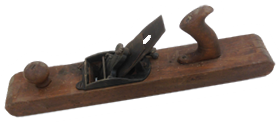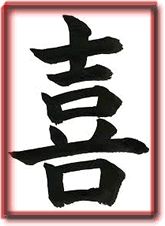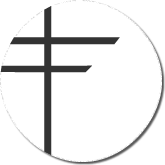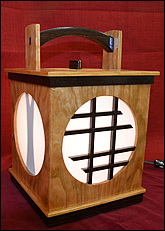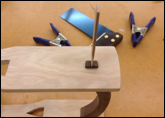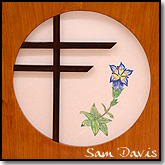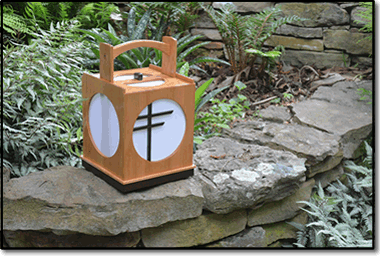Shoji Lamps
A trip to the woodworking section of Powell's Bookstore in Portland, Oregon in the summer of 2015 lead to readings on building Japanese-style shoji lamps. This project series now numbers five designs.
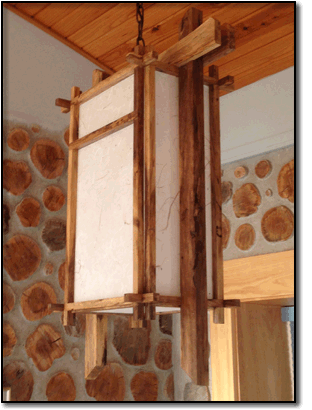 |
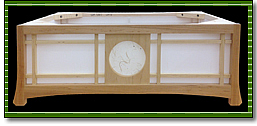 |
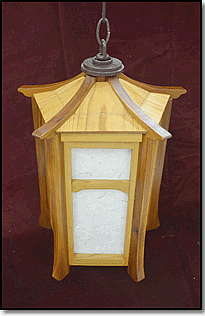 |
| Basho Hanging Lantern | Takara Ceiling Mounted Lamp | Pagoda Lantern |
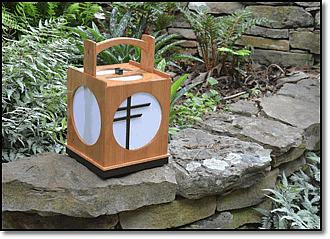 |
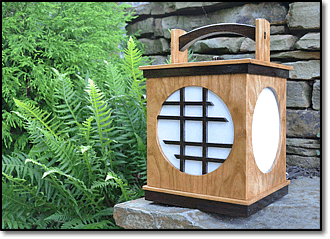 |
| Box Table Lamp - Friendship | Box Table Lamp - Equality |
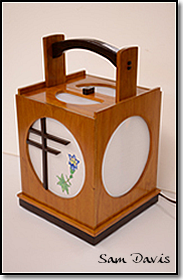 |
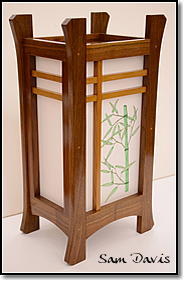 |
| Box Table Lamp - Gratitude | Table Lamp - ESSA |
![]()
Inspired by fellow woodworker and long-time friend Bill Winfield and his miniature "Chinese Scholar's Garden", and readings on Vancouver, B.C. artist Edward Turner...this project series is a set of Japanese-inspired light fixtures. The blending of shoji paper, native materials and light has been an inspiration to me.
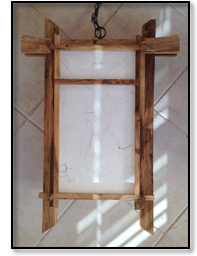
The first piece is a Basho Ceiling Lantern, based on Edward Turner's work, which demanded a fresh approach to my design and construction process. Studying the text of Japanese shoji-maker, Toshio Odate, lead to a path toward more handwork in the joinery and the expanded use of traditional Japanese woodworking tools and methods.
Brief description of project:
Dimensions - 23" high x 12" wide x 9" deep. The wooden frame is spalted Persimmon wood from a downed tree near my shop. The shoji paper is a Kozo paper with small pieces of bark and twine embedded in it. It is a laminated paper that is .2 mm thick with a polyester core sandwiched by outside layers of Mulberry paper for strength.

Basho lantern installed in cordwood sunroom. (left)
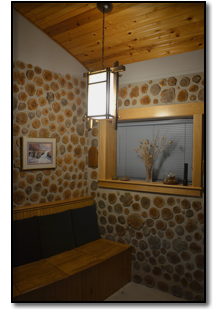 |
| Lamp provides a pleasing ambient glow later in the evening with a 60 w LED bulb. (above) |
| Jig for cutting joints in kumikos(right): this tool securely holds the 1/2" x 1/2" Persimmon stock for the Dozuki saw to gauge and cut half-lap joints near each corner to join the kumiko frames. Kozo paper is attached on the inside of each frame. | 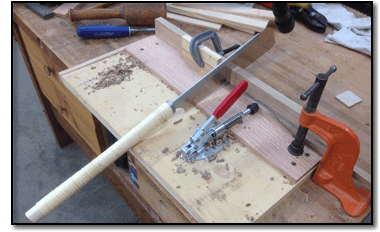 |
See Basho Photo Gallery
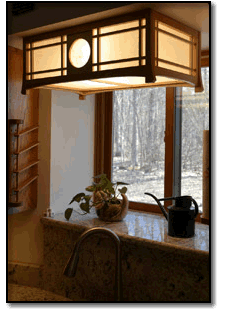 The next shoji lamp in the series is a ceiling-mounted fixture called "Takara" or treasure chest. It is installed over existing bulb sockets above the kitchen sink in Arkwood Cottage. It is an original design with the proportions of a small chest.
The next shoji lamp in the series is a ceiling-mounted fixture called "Takara" or treasure chest. It is installed over existing bulb sockets above the kitchen sink in Arkwood Cottage. It is an original design with the proportions of a small chest.
Brief description of project:
Dimensions - 9"" high x 25" wide x 14" deep. This lamp is designed to serve a combination of task lighting downward and ambient lighting on it's four faces to light the area around the kitchen window. The kumikos are more slender (3/8" x 3/8") and are mounted in a mortise and tenon outer frame (photo below). It is made from Iowa Soft Maple, to unify the adjacent kitchen island and light fixture. The joinery in this project was a challenge with some 86 total joints cut with handsaw, chisel, and mallet.
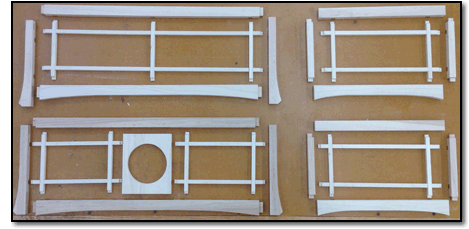
Hi-tec laminated kozo paper -- "Cloud Dragon" design with small silk fibers embedded in it -- is attached to the inside of each face for ambient lighting of the area around the sink. A styrene plastic panel is necessary on the bottom for increased light transmission for task lighting.
Photo (right) shows Takara panels before assembly, with (clockwise) rear panel at upper left, sides and front panel.
See Takara Photo Gallery
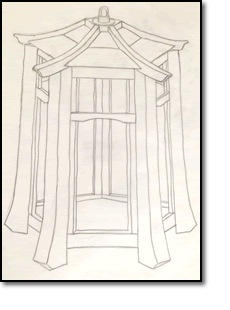 Design #3 in the shoji lamp series was built for a friend, JK, based on a rough sketch he drew. He wanted a pentagon-shaped hanging lantern for the living
room in his rustic country home. I based the pagoda lamp on architectural lines found in Japanese temples, with a Craftsman-style layered in. We texted back and forth and collaborated on the final concept. The final sketch (on the left) that I drew was the starting point for the lamp design.
Design #3 in the shoji lamp series was built for a friend, JK, based on a rough sketch he drew. He wanted a pentagon-shaped hanging lantern for the living
room in his rustic country home. I based the pagoda lamp on architectural lines found in Japanese temples, with a Craftsman-style layered in. We texted back and forth and collaborated on the final concept. The final sketch (on the left) that I drew was the starting point for the lamp design.
Brief description of project:
Dimensions - 16" high x 9" wide. This "Pagoda" or temple lamp is designed to provide maximum ambient room lighting, with a 100 w LED bulb, controlled by a dimmer switch. The bottom of the lamp is open to more brightly illuminate the seating area underneath. It is made from Western Red Cedar, using a lighter toned sapwood for the kumiko frames and roofing, with darker heartwood for the roof beams and pillars that separate each kumiko panel. A "bark and twine" embedded kozo paper was installed in each of the five side panels to enhance the organic qualities of the lamp.
This lamp had it's challenges: primarily the pentagon shape and the roof lines.  I had to build a jig to hold the kumiko panels at the correct angle to run them through the table saw. Pentagon angles are 108 degrees (sum of angles = 540 deg) or a 54 degree cut on the long edge of each panel. Once the panels were assembled, cut with the jig, and glued-up...each of the five intersecting edges was hand-planed to a flat surface for the pillars to rest. This enhances the architectural feel of the temple, giving the appearance of the pillars holding up the roof.
I had to build a jig to hold the kumiko panels at the correct angle to run them through the table saw. Pentagon angles are 108 degrees (sum of angles = 540 deg) or a 54 degree cut on the long edge of each panel. Once the panels were assembled, cut with the jig, and glued-up...each of the five intersecting edges was hand-planed to a flat surface for the pillars to rest. This enhances the architectural feel of the temple, giving the appearance of the pillars holding up the roof.
See Pagoda Photo Gallery

|
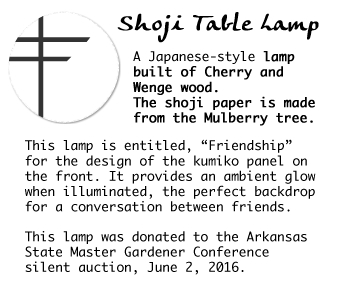
|
The design for the Shoji Box Table Lamp -" Friendship" is based on Edward Turner's "Candle in the Wind" lamp, a traditional hand-carried candle-powered lamp that one might carry at night to light the pathway, with paper sides to shield the wind.
Brief description of project:
The handle is through-mortised and wedged into the handle supports. The compound curvature of the handle reflects the geometric lines of a traditional Japanese bridge over a small body of water. I added an Ozark twist by cutting the handle supports in the profile of the native white oak trees in the woods around my shop. The dimensions are @ 8" x 8" x 13", as small as practicable with circles of 6" on each face to provide as much illumination as possible to balance with enough wood to provide sufficient structure.
The kumikos are a narrower profile, 1/4" x 1/4" instead of the 3/8" x 3/8" in the Basho Lantern, as a more delicate design statement. The side panels are made of two pieces of bookmatched 1/4" thick Pennsylvania Cherry. This choice was partly for balance in appearance and partly for the economy of resawing thicker stock and maximizing material. I chose Wenge wood as a contrast color and texture against the Cherry, using it to accent the base, kumikos and handle wedges. It was not as easy to work with, but it's lovely dark cocoa tone turned almost black with the oil/varnish finish. Nice.
Designing and building a jig for cutting perfect circles, which minimize sanding and dust was the biggest challenge for me on this project. Plus, the jig had to accomodate the different heights of the front/back faces vs. the side heights. A plunge router with a downcutting 1/4" spiral bit really did the job. To take advantage of the process I cut out enough material for eight lamps in about an hour. One lesson learned on this project was to think very carefully on the production sequence. Unlike the custom furniture work that I do, there is less freedom in the sequence of construction, particularly with finishing parts around the shoji paper in advance of later gluing and assembly. This lamp served as a prototype, an opportunity to explore all the ins and outs of my original design. Some of the design changes can be seen in the "Equality" box lamp version.
See Friendship Box Lamp Photo Gallery
Shoji Box Lamp Variations
Even before the prototype is completed, new ideas pop up for variations on it's design.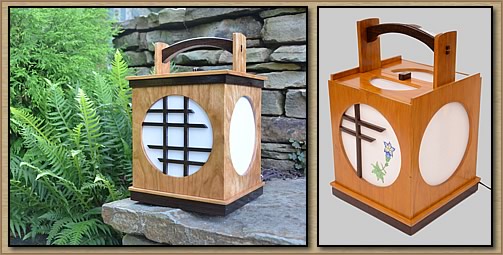 "Equality" (Left) was designed as a wedding present for my daughter. A wild grain on the cherry lamp body sets off the built-up, more formal top cap and wenge trim. The front kumiko panel features a more intricate symmetrical pattern, representing equality in marriage, with sixteen joints to fit. The same oil/varnish finish was repeated from the prototype.
"Equality" (Left) was designed as a wedding present for my daughter. A wild grain on the cherry lamp body sets off the built-up, more formal top cap and wenge trim. The front kumiko panel features a more intricate symmetrical pattern, representing equality in marriage, with sixteen joints to fit. The same oil/varnish finish was repeated from the prototype.
"Gratitude" (Right) was a gift, given as an expression of my gratitude to lifelong friends in Wisconsin for 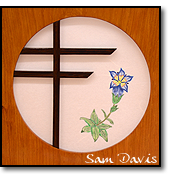 their many years of kindness and friendship. I had begun to play with ink illustrations and wanted to try that on a lamp. The laminated paper was not an easy surface to work on: tendency for ink to bleed. A very dry brush was critical. The ink design,
a Gentian flower, was inspired by English artists circa 1900. They sought to express emotions through different plant forms: Gentian represented gratitude.
their many years of kindness and friendship. I had begun to play with ink illustrations and wanted to try that on a lamp. The laminated paper was not an easy surface to work on: tendency for ink to bleed. A very dry brush was critical. The ink design,
a Gentian flower, was inspired by English artists circa 1900. They sought to express emotions through different plant forms: Gentian represented gratitude.
I also wanted to experiment with new finishes. I bought some ruby shellac flakes and struggled through my first shellac finishing project. After finally figuring out that the correct brush (a hake) and application techniques (don't overwork it) were the key (check out Paul Sellers on YouTube), frustration melted into a pleasing result. Top coating the shellac with bees wax really set it off.
![]()

A new lamp design, ESSA, was a prototype lamp for teaching the application of shoji joinery to lamp making for a class at the Eureka Springs School of the Arts in 2017. My student Bill helped me out by testing the lamp curriculum, and he got a take home lamp out his experience. I built this illustrated version alongside Bill's lamp. I learned a lot about teaching this particular project. The ESSA class did not make, not enough registrations, but the lamp rests at Arkwood...and it inspired another student, Jerry, to build his take on the design in 2020, at a 125% scale of the original.
